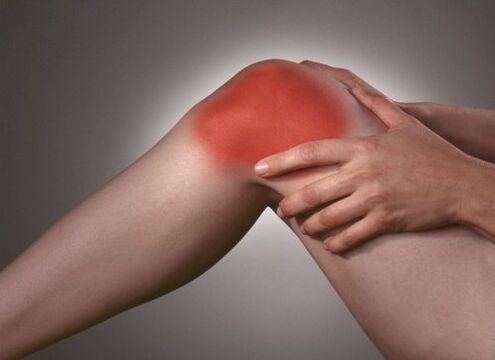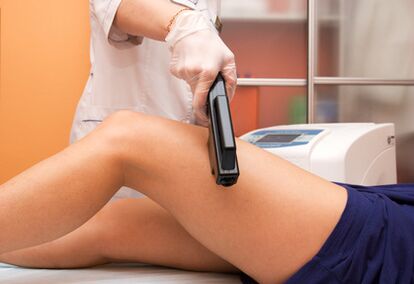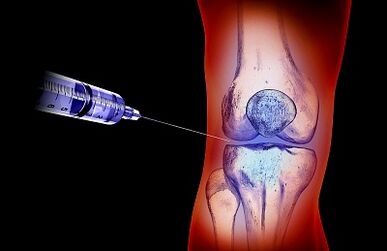
The knees, like other joints, are made up of bones and cartilage.Cartoon is a smooth, elastic and elastic layer that guarantees Gait facilities and friction deficiency.Damage to the cartilage by chronic wear calledArthrosis of the knee joint.
There are many factors that lead to knee joint arthrosis:
- genetic tendency;
- overweight;
- abnormal movement;
- injury.
For a long time, one has not suffered pain and only when knee arthrosis leads to strain deformation, the first symptoms appear.The patient consulted a doctor, but the treatment of advanced disease was successful.
Knee joint arthrosis is often caused by accidents and injuries, but can be seen only after a few years.Therefore, with a little suspicion of the disease, you should consult your doctor.
Symptoms of arthrosis of the knee joint
Symptoms of knee joint arthrosis include:

- pain increases during activity;
- swelling;
- increase skin temperature;
- decrease in knee joint movement;
- The Creak, a crisp sound heard during movement.
Pain after non -acting period is one of the most common symptoms of knee arthrosis.She expresses herself in the morning, when the joints need time to warm up in the right way.After a person like a moment, the pain decreases.
Sometimes you can see the first signs of knee arthrosis by just looking at it.Although the knees stick more than usual, this may be the first sign.Increased knee tendency to swell is easily recognized.Bulge in the thick finger is formed on the knee cup, as this place is the weakest.This is due to the increase in fluid accumulation in the joints.
Mengurangkan fleksibiliti di kaki mungkin menunjukkan arthrosis sendi lutut.Those who have been able to touch the heel of the back, stand on one foot, but can go half way today, should consult a doctor.Otot paha boleh mula bekerja lebih sukar daripada sebelumnya, kerana arthrosis lutut, menjadi lebih pendek, dan mula terluka.Otot -otot ini perlu diregangkan dan diperkuat untuk memulihkan fungsi sebelumnya.
Another sign of knee joint arthrosis is a decrease in muscle strength in the foot.
Arthrosis turns cartilage, which is as smooth as glass into a coarse cloth that looks like sandpaper in the early stages.When the surface is rubbing each other, you can hear the sound and friction sound in the joints.
How is the knee arthrosis diagnosed?

Diagnosis of knee osteoarthritis begins with a medical examination by a doctor.Before taking it, determine what has arisen to help the doctor make the right diagnosis.In addition, find out if someone has arthritis in your family.
Your doctor may prescribe additional diagnosis, including:
- Magnetic resonance imaging (MRI) scans x-rays that can indicate bone and cartilage damage, as well as the presence of spurs;
- MRI can be ordered when X-rays do not give the cause of joint pain or when X-rays indicate that other types of joint tissue can be damaged.Doctors can use blood tests to exclude other conditions that can cause pain, such as rheumatoid arthritis, another type of arthritis caused by the affected immune system.
How is the knee joint arthrosis treated?
The main task of treating osteoarthritis of the knee joint is the release of pain and the return of mobility.
Plans, as a rule, including a combination of the following actions:
- Weight loss.Loss of weight, if necessary, can reduce the pain in the knee from osteoarthritis.
- Exercise.Strengthening the muscles around the knee makes the joint state more stable and reduces pain.Stretching exercises help keep your knees with mobile and flexible.
- Anesthetic and anti -anti -anti -anti:Acetaminophen, ibuprofen or sodium.If the medication does not bring relief, your doctor can give you a prescription of other anti -inflammation to help relieve pain.
- Corticosteroid injection or hyaluronic acid in the knee.Steroids are a powerful anti -inflammatory drug.Hyaluronic acid is usually found in the joints as a type of lubricant, but with joint disease it is less off.
- Alternative treatment methods.Some alternative treatment methods that can be effective include: capsaicin cream, acupuncture, or additives, including glucosamine and chondroitin.
- Using devices such as brackets.There are two types of brackets: those who unload braces, thus removing weight from the knee;and "support" brackets that provide support for the entire knee.
- Physical activity and labor therapy. If you have problems with daily activities, physical training or labor therapy can help.Physiotherapists will teach you how to strengthen your muscles and increase the flexibility of the joints.Experts will set up a set of exercises that are right for you to appear at home to reduce pain.
- Surgery.When other treatment methods do not work, surgery is the only option to get rid of the disease.

Is surgery used to treat knee osteoarthritis?
For the treatment of knee osteoarthritis with the help of surgical intervention, the following options are possible: arthroscopy, osteotomy, endoprosthetics.
OnArthroscopySmall telescopes (arthroscope) and other small tools are used.This operation is carried out through a small incision.Surgeons use arthroscope so that joints can be seen.After the surgeon can remove the cartilage or free particles, he can clean the surface of the bone.This procedure is often used in patients 55 (and younger) to slow down more serious surgery.
Osteotomy- This is a procedure aimed at altering the knee, changing the shape of the bone.This type of operation can be recommended if you have damage, first of all, in one knee area.It can also be recommended if you damage your knees and it has not been restored.Osteotomy has no continuous effect and surgery may be needed in the future.
Endoprosthetics- This is a surgical procedure in which the joints are replaced by a metal or plastic part.Replacement may include one side or all knees.As a rule, people over the age of 50 and severe forms of osteoarthritis require replacement.This operation may be needed later, if the replacement runs out after several years, but with modern achievements, most prostheses have served for more than 20 years.This operation is at risk, but the results are usually very good.



















